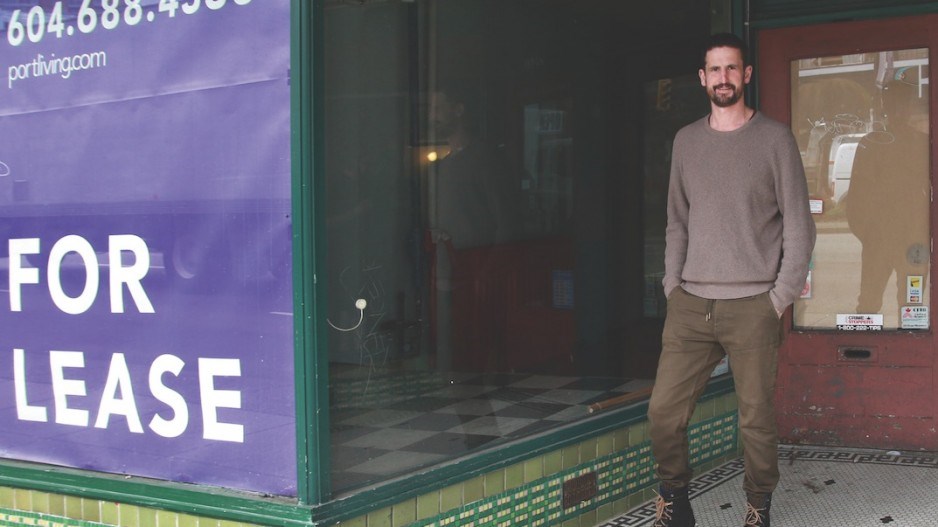Restaurateur Pepe Barajas’ experience with the City of Vancouver highlights the need for streamlined city hall processes to approve tenant-improvement permits.
It also illustrates why so many arterial streets in the city are peppered with for-lease signs in storefront windows or retail units papered up to show that new tenants plan to move in.
Business improvement association heads say some vacancy is a healthy sign of renewal but too much saps energy from streets and stalls growth for existing businesses.
Barajas’ saga started in September 2016, when he leased a 3,200-square-foot unit near East 16th Avenue and Main Street, where he had intended to turn what had been a furniture store into a Mexican restaurant.
The Business in Vancouver 2017 Forty under 40 winner had opened many restaurants, and he had no reason to think that this experience would be any different.
After Barajas applied to the city to change the use of the space to a restaurant, he said city staff wrongly told him that he required 24 parking spots.
Barajas then had to go to the city’s board of variance, which confirmed that his restaurant did not need any on-site parking. By this time, six months had passed. He told BIV that he had to pay more than $12,000 per month in rent for each of those months as well as about $20,000 in fees to professionals to help him with his appeal of the city’s decision. He then had to wait for city staff to approve a change-of-use application for the site.
Other delays came when professionals he had planned to hire became otherwise occupied because they were not sure when Barajas would be able to hire them.
The end result is that he is more than $360,000 out of pocket, and he has given up on conducting the necessary improvements to the site. He continues to pay more than $12,000 per month on the empty storefront while he seeks a tenant willing to sublease the space.
“One of the biggest issues with empty storefronts is the process of permitting,” said Michael Wiebe, co-president of the Mount Pleasant Business Improvement Association and a BC Green Party candidate for city council.
“Go to Kingsgate Mall right now and you’ll see all these empty storefronts. They’re all rented. They just take a long time to go through permitting so they sit vacant.”
The city’s general manager of development, buildings and licensing, Kaye Krishna, told BIV she is aware that business owners say that it takes an inordinate amount of time to get required city permits for tenant improvements.
“From engagement, we’ve learned that it’s not always the city’s fault that we’re delaying something,” she said. “It’s confusion around what needs to happen. For example, we saw a couple different situations where people signed long-term leases for retail spaces, but the zoning didn’t enable the type of retail that they were planning to put in that space. They didn’t know that.”
Krishna said her department has made it a priority to “evaluate and understand the process and what the issues are and come up with recommendations on how to fix it.”
Recent city moves to streamline tenant-improvement permits include:
•updating the city’s sign bylaw, which Krishna called “complicated and onerous”;
•getting feedback on how to improve processes from stakeholders such as commercial real estate association NAIOP, the Urban Development Institute and business improvement associations (BIAs); and
•launching a commercial renovation centre for small-business owners to ask questions one-on-one with city staff.
Wiebe said the city and the province could do more to help empty storefronts get filled.
He has heard some people suggest that the city levy a tax on empty storefronts, but neither he nor other BIA heads such as South Granville Business Improvement Association executive director Sharon Townsend favour such a move. BIAs, after all, are funded by commercial property owners.
Instead, Wiebe would like to see store owners pay less tax and therefore have more capacity to make a go of their businesses.
He also wants the city to shift its tax base from being 46% provided by commercial property owners and 54% by residents to being slightly less than that from commercial property owners and slightly more from residents.
The province could also change the way it assesses the value of commercial properties – something that factors into the formula that the city uses to charge property taxes.
The current assessment for a one-storey commercial building on Broadway, for example, is likely to be for six storeys of commercial use because that is what the property is zoned for.
If that tax assessment were instead for one level of commercial on the ground, under five levels of unbuilt homes, the tax would be significantly less, Wiebe said.
That is because commercial properties are assessed at a tax rate that is 4.87 times that of a residential property.
Wiebe also suggests that the city levy taxes based on the average tax rate for the past five years. That would give business owners time to contemplate downsizing, moving or saving money if a property’s value jumps substantially in one year.
“Some properties in Mount Pleasant have gone up in value 100% in a year,” Wiebe said.
“We’re not giving the business the time to deal with that shift. A five-year averaging would help.” •




